26072323311568661931
43744839742282591947
118132654413675138222
186378732807587076747
519650114814905002347
Any three of these numbers add up to a perfect square.
(Discovered by Stan Wagon.)
26072323311568661931
43744839742282591947
118132654413675138222
186378732807587076747
519650114814905002347
Any three of these numbers add up to a perfect square.
(Discovered by Stan Wagon.)
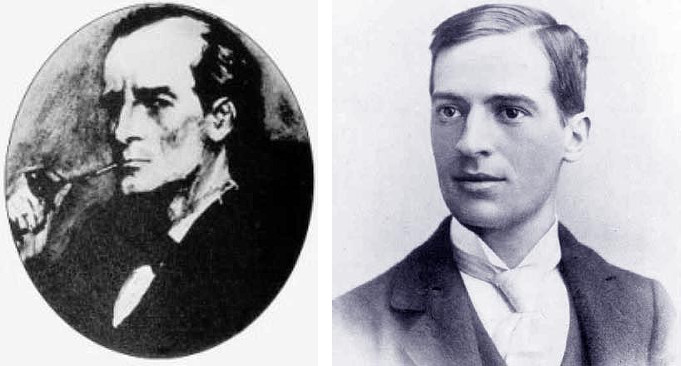
Disguises adopted by Sherlock Holmes:
In 1895 the Brooklyn Chess Club sent young Harry Nelson Pillsbury to England to compete in the great tournament at Hastings. He took first prize but never matched this early success and died in 1906. “Nobody can understand this sudden flash of greatness,” wrote New York Times music critic Harold Schonberg. “A twenty-two-year-old unknown licked the cream of Europe’s experts, trouncing such formidable masters as Lasker, Tarrasch, Tchigorin, Gunsberg and Mieses.” Schonberg suggested that the mystery is easily solved if the victor at Hastings was not Pillsbury but “the finest analytical mind in Europe, the mind of one who had genius, infinite capacity for concentration, and a brilliant insight into chess. Suppose that it was Sherlock Holmes, the master of disguise, who impersonated Pillsbury at Hastings, letting Pillsbury, on his own after that, sink to his normal level.”
(From The Annotated Sherlock Holmes, 1975, and The New Annotated Sherlock Holmes, 2007.)

An old “puzzler” from NPR’s Car Talk:
Thirty buyers attended an auction of dozens of cars. Ten of the buyers bought fewer than 6 cars; eight bought more than 7 cars; five bought more than 8 cars; and one bought more than 9 cars.
Of the 30 buyers, how many bought 6, 7, 8, or 9 cars?
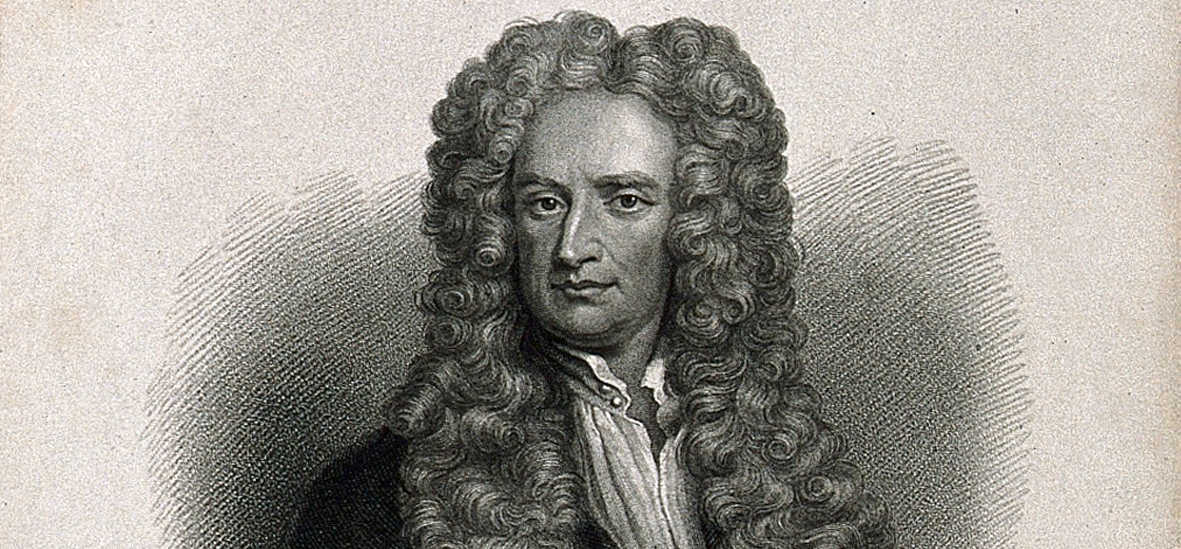
In 1662, while a student at Cambridge, 19-year-old Isaac Newton made a list of 57 sins he’d committed:
Before Whitsunday 1662
Using the word (God) openly
Eating an apple at Thy house
Making a feather while on Thy day
Denying that I made it.
Making a mousetrap on Thy day
Contriving of the chimes on Thy day
Squirting water on Thy day
Making pies on Sunday night
Swimming in a kimnel on Thy day
Putting a pin in Iohn Keys hat on Thy day to pick him.
Carelessly hearing and committing many sermons
Refusing to go to the close at my mothers command.
Threatning my father and mother Smith to burne them and the house over them
Wishing death and hoping it to some
Striking many
Having uncleane thoughts words and actions and dreamese.
Stealing cherry cobs from Eduard Storer
Denying that I did so
Denying a crossbow to my mother and grandmother though I knew of it
Setting my heart on money learning pleasure more than Thee
A relapse
A relapse
A breaking again of my covenant renued in the Lords Supper.
Punching my sister
Robbing my mothers box of plums and sugar
Calling Dorothy Rose a jade
Glutiny in my sickness.
Peevishness with my mother.
With my sister.
Falling out with the servants
Divers commissions of alle my duties
Idle discourse on Thy day and at other times
Not turning nearer to Thee for my affections
Not living according to my belief
Not loving Thee for Thy self
Not loving Thee for Thy goodness to us
Not desiring Thy ordinances
Not [longing] for Thee in [illegible]
Fearing man above Thee
Using unlawful means to bring us out of distresses
Caring for worldly things more than God
Not craving a blessing from God on our honest endeavors.
Missing chapel.
Beating Arthur Storer.
Peevishness at Master Clarks for a piece of bread and butter.
Striving to cheat with a brass halfe crowne.
Twisting a cord on Sunday morning
Reading the history of the Christian champions on Sunday
Since Whitsunday 1662
Glutony
Glutony
Using Wilfords towel to spare my own
Negligence at the chapel.
Sermons at Saint Marys (4)
Lying about a louse
Denying my chamberfellow of the knowledge of him that took him for a [illegible] sot.
Neglecting to pray 3
Helping Pettit to make his water watch at 12 of the clock on Saturday night
“We aren’t sure what prompted this confession,” writes Mitch Stokes in his 2010 biography of the physicist. “Some biographers think that it was in response to an inner crisis. Perhaps it was the occasion of his conversion, or at least of his ‘owning his faith.’ We simply don’t know.”
University of Minnesota percussionist Gene Koshinski’s composition “As One” has two performers (here, Koshinski and Tim Broscious) complementing each other on identical setups, splitting one complex piece into two complex halves.
More about Koshinski at his website.

In his letters, Tchaikovsky comes to two contrary impressions of Venice in the space of three years:
April 17, 1874: “Now I will tell you about Venice. It is a place in which — had I to remain for long — I should hang myself on the fifth day from sheer despair. The entire life of the place centres in the Piazza San Marco. To venture further in any direction is to find yourself in a labyrinth of stinking corridors which end in some cul-de-sac, so that you have no idea where you are, or where to go, unless you are in a gondola. A trip through the Canale Grande is well worth making, for one passes marble palaces, each one more beautiful and more dilapidated than the last. In fact, you might suppose yourself to be gazing upon the ruined scenery in the first act of Lucrezia. But the Doge’s Palace is beauty and elegance itself; and then the romantic atmosphere of the Council of Ten, the Inquisition, the torture chambers, and other fascinating things. I have thoroughly ‘done’ this palace within and without, and dutifully visited two others, and also three churches, in which were many pictures by Titian and Tintoretto, statues by Canova, and other treasures. Venice, however — I repeat it — is very gloomy, and like a dead city. There are no horses here, and I have not even come across a dog.”
November 16, 1877: “Venice is a fascinating city. Every day I discover some fresh beauty. Yesterday we went to the Church of the Frati, in which, among other art treasures, is the tomb of Canova. It is a marvel of beauty! But what delights me most is the absolute quiet and absence of all street noises. To sit at the open window in the moonlight and gaze upon S. Maria della Salute, or over to the Lagoons on the left, is simply glorious! It is very pleasant also to sit in the Piazza di San Marco (near the Café) in the afternoon and watch the stream of people go by. The little corridor-like streets please me, too, especially in the evening when the windows are lit up. In short, Venice has bewitched me … To-morrow I will look for a furnished apartment.”
(Thanks, Charlie.)
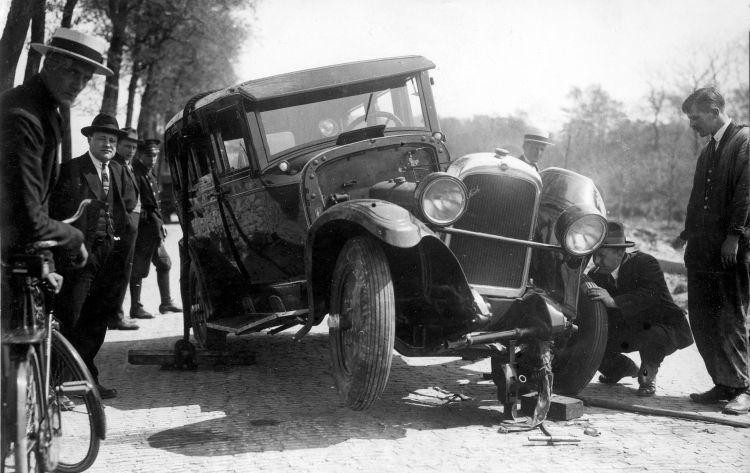
Hold on to your seats, boys. This one gets complicated.
It seems that on Aug. 12, 1940, there occurred an automobile collision at Forty-second avenue S. and Forty-second street.
A car driven by Leo R. Johnson, Hopkins, and owned by Frank M. Anderson, 2912 Sixteenth avenue S., was in collision with one driven by Francis D. Hall, 3413 E. Minnehaha parkway.
It happened that both owners were insured with the same company, the Westchester Fire Insurance Co., and both had $50 deductible collision policies.
The company paid $65 to Anderson for damages to his car and $300 to Hall for damages to his car.
Then the company started suit in municipal court to recover the money.
Action was started against Hall to recover the $65 paid for damages to Anderson’s car, charging him with negligence, and against Anderson to recover the $300 paid for damages to Hall’s car, charging Johnson, the driver, with negligence. …
Benjamin Rigler, attorney for Hall, then came into court with an answer denying that his client was negligent and charging that the driver of Anderson’s car was the negligent party.
And A.C. Johnston, attorney for Anderson, came into court with an answer denying that Johnson was negligent in driving and charging that Hall was guilty of contributory negligence.
The insurance company then filed replies to both answers, denying them.
Since it denied the answers, it also denied each answer’s charge that the other party was guilty of negligence, and thus denied its own original complaint.
Today the attorneys moved for dismissal on the ground that the reply to the answers was ‘sham and frivolous.’
Municipal Judge William A. Anderson dismissed both cases.
(From William L. Prosser’s The Judicial Humorist, 1952. The author is unknown.)
For what it’s worth: In 2015 University of Wisconsin psychologists Megan Savage and Charles Snowdon considered that music might appeal better to other species if it used the same tempos and frequency ranges that they use to communicate.
Accordingly they got musician David Teie to compose three songs that ought to appeal to felines and tried them out on 47 domestic cats, comparing their reactions to Bach’s “Air on a G String” and Fauré’s “Elegie.” The cat music was pitched about an octave higher than human voices, and its tempos replicated purring and suckling rather than a human heartbeat.
The cats showed no interest in the music intended for humans, but they showed a “significant preference for and interest in” Teie’s cat-targeted songs, approaching the speakers and often rubbing their scent glands on them. Also, for some reason young and old cats seemed to like the cat music better than middle-aged ones.
Savage and Snowdon conclude that these results “suggest novel and more appropriate ways for using music as auditory enrichment for nonhuman animals.” Here’s a sample to try on your own cat:
(Charles T. Snowdon, David Teie, and Megan Savage, “Cats Prefer Species-Appropriate Music,” Applied Animal Behaviour Science 166 [May 2015], 106–111.) (Thanks, Noah.)
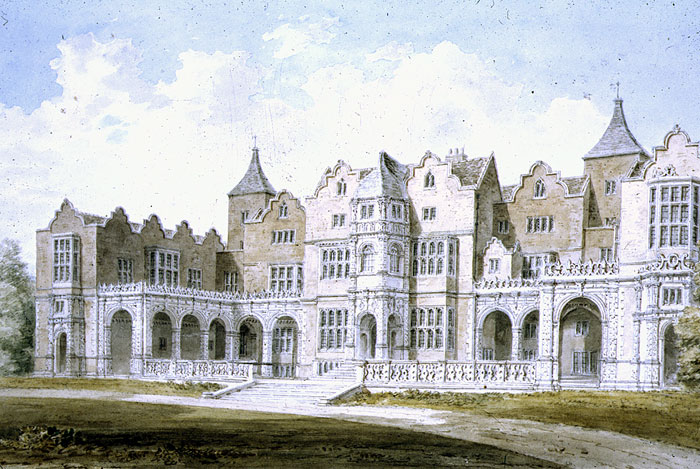
One more example of the trials of 19th-century house servants — in 1832 Elizabeth Fox, Baroness Holland, strained a sinew in her back:
Lady Hardy … said to her hostess after dinner, in the presence of the gentlemen, ‘Is it very painful? Where is it?’ Upon which her Ladyship called her page, made him turn his back to her, put her finger on his posterior regions, and said, ‘Here, Lady Hardy.’
(From Giles Fox-Strangways’ 1937 Chronicles of Holland House, 1820-1900.)
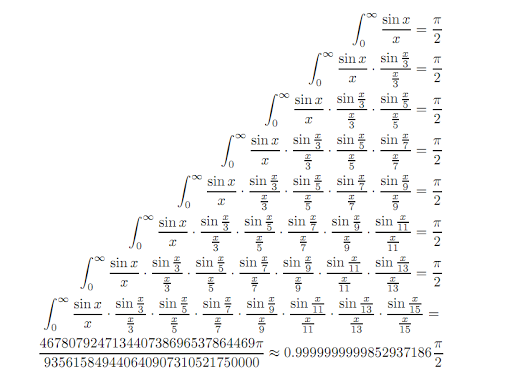
These are called Borwein integrals, after David and Jonathan Borwein, the father-and-son mathematicians who first presented them in 2001.
Engineer Hanspeter Schmid writes, “[W]hen this fact was recently verified by a researcher using a computer algebra package, he concluded that there must be a ‘bug’ in the software. It is not a bug, though; this series of integrals really only results in π/2 up to a certain point, and then breaks down. This astonishes most mathematically educated readers, as especially those readers mentally extrapolate the sequence shown above and find it surprising that something fundamental should change when the factor sinc(x/15) is introduced.” He gives a graphic explanation of what’s happening.
(David Borwein and Jonathan M. Borwein, “Some Remarkable Properties of Sinc and Related Integrals,” Ramanujan Journal 5:1 [March 2001], 73–89.) (Thanks, Dan.)